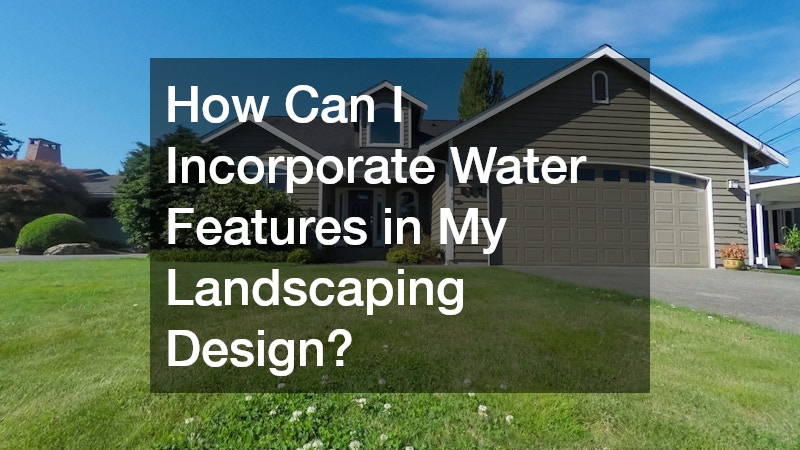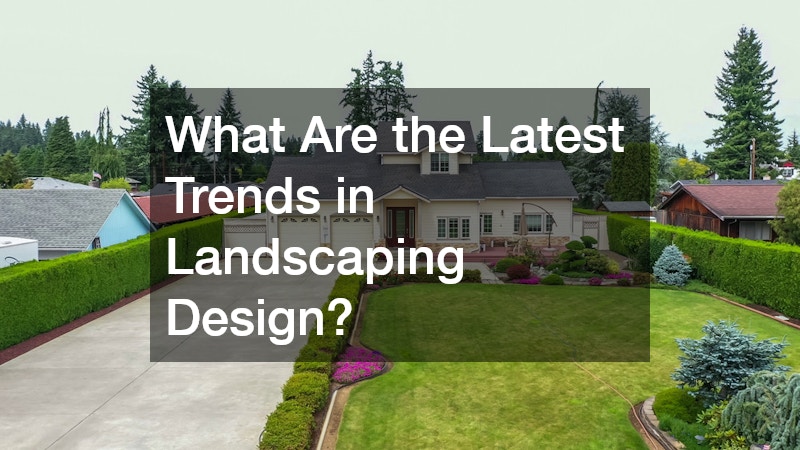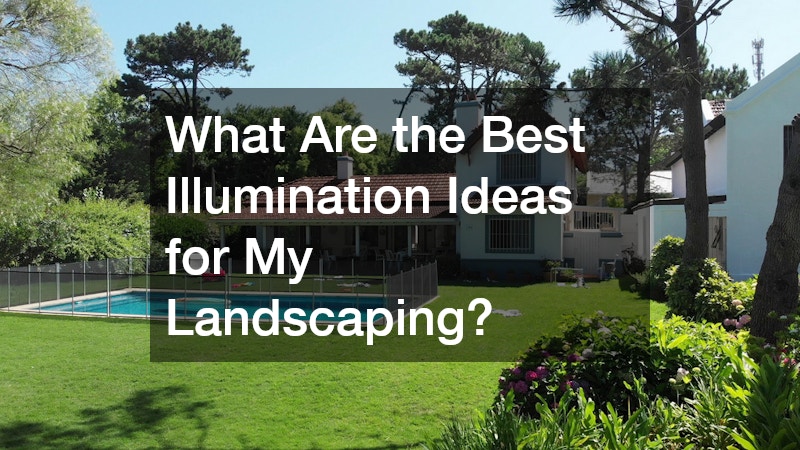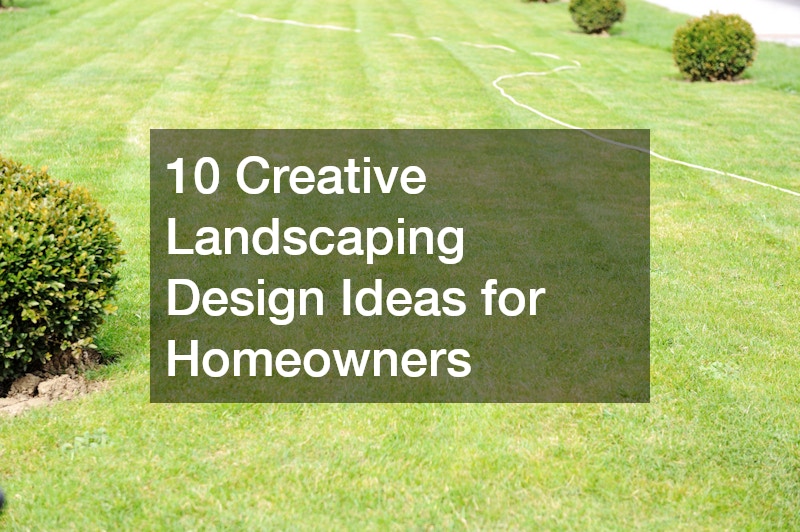As homeowners, we continuously look for ways to enhance the beauty and functionality of our outdoor spaces. Creative landscaping design plays a crucial role in achieving that objective and can significantly increase the curb appeal of your property. Integrating unique landscaping elements not only adds aesthetic value but also enhances the practical use of your yard or garden. By employing inventive concepts, homeowners can craft outdoor sanctuaries that are both visually stunning and sustainable. This article presents ten compelling creative landscaping design ideas that cater to those keen on revitalizing their green spaces. Each section delves into innovative approaches that blend artistic flare with environmental sensibility, urging you to implement these ideas to elevate the ambiance and functionality of your outdoor sanctuary.
How Can I Incorporate Water Features in My Landscaping Design?

Water features are a striking way to add an element of tranquility and elegance to your creative landscaping design. They serve as focal points within the landscape, drawing the eye and offering a peaceful ambiance. Homeowners can choose from a variety of water features, such as ponds, fountains, and waterfalls, each providing unique aesthetics and sounds that complement the garden’s atmosphere. Thoughtful placement and appropriate sizing are crucial to achieving the desired effect without overwhelming the space.
Additionally, incorporating water features can provide environmental benefits by supporting local wildlife and improving biodiversity. For instance, a small pond can attract frogs, birds, and beneficial insects, aiding in natural insect and grub control. The presence of a water source encourages a balanced ecosystem, fostering the growth of flora and fauna necessary for a thriving garden.
Installation of water features can be scalable to suit any budget or garden size. Simple DIY projects can transform a small area with minimal expense, while more elaborate installations might require professional assistance. With well-considered design and proper maintenance, water features enhance the allure of any garden while demonstrating the homeowner’s commitment to innovative landscaping design.
What Are Some Creative Planting Designs?
Creative planting designs breathe life into any garden by introducing diverse textures, colors, and forms. Grouping plants with similar growing requirements yet different appearances can create dynamically layered visuals reminiscent of an artist’s canvas. Strategic use of perennials, annuals, and ornamental grasses enhances the aesthetic value while complementing existing hardscaping services such as paths and patios.
Plant selection should reflect the garden’s microclimate and the homeowner’s maintenance preferences. Native plants are an excellent choice, as they are well-adapted to your region’s soil, climate, and pest challenges, making landscape maintenance more manageable. They also support local ecosystems by providing nectar and habitat for insects, birds, and other wildlife, reinforcing your garden’s ecological credentials.
Incorporating edible plants into the landscape offers visual appeal and practical benefits. Herb and vegetable gardens introduce interesting textures and scents, making them a delightful addition to any creative landscaping design. Raised beds or in-ground plantings can be tactfully arranged to blend with existing hardscapes, promoting both beauty and bounty. With thoughtful integration, your garden can become a lush and vibrant outdoor retreat.
How Do I Design a Sustainable Landscape?
Sustainable landscapes coalesce the beauty of nature with eco-friendly practices. Creating an eco-conscious design begins with mindful plant selections that thrive with minimal intervention—prioritizing native and drought-tolerant species can reduce water usage significantly. This strategic choice demonstrates responsible stewardship, aligning aesthetic concerns with ecological soundness.
Implementing sustainable landscape maintenance practices is also pivotal. Opt for organic mulches, which suppress weeds and retain soil moisture while enhancing the garden’s visual appeal. Composting garden waste promotes nutrient-rich soil naturally, reducing dependence on synthetic fertilizers. By fostering a healthy soil ecosystem, homeowners can support a robust landscape resilient to pests and diseases.
Designing a sustainable landscape necessitates considering environmental impacts at every stage. Incorporating rainwater harvesting systems allows homeowners to manage water resources effectively, supplementing irrigation needs during dry spells. Additionally, strategically placing permeable paving reduces runoff and supports ground water replenishment. By embracing sustainable designs, homeowners can create enduring landscapes that coexist harmoniously with the environment.
What Are the Latest Trends in Landscaping Design?

Landscaping trends constantly evolve, mirroring shifts in aesthetics, lifestyles, and environmental awareness. Recent trends emphasize mixing organic textures with structured forms, resulting in chic and functional spaces. Incorporating retaining walls with natural stone or engineered blocks to shape the landscape has gained popularity for its ability to define areas and manage topography efficiently.
Another notable trend is designing multi-functional outdoor living areas. Creative hardscapes serve as extensions of indoor spaces, supporting versatile uses such as dining, relaxation, and entertainment. Custom features like outdoor kitchens, fire pits, and seating nooks enhance these spaces, fostering a fusion of comfort and nature in creative landscaping design.
Moreover, the trend towards sustainability in landscaping design involves integrating energy-efficient lighting and irrigation systems. Smart technology can optimize resource use while elevating convenience and enjoyment. By adopting these contemporary trends, homeowners can craft visionary landscapes that embody both modernity and eco-responsibility.
How Do I Create a Wildlife-friendly Garden?
Wildlife-friendly gardens foster biodiversity by incorporating native plants, offering habitat and nourishment for various species. The careful selection of flowering plants and nectar-rich blossoms, alongside food-producing shrubs and trees, supports pollinators and other beneficial wildlife. This contributes to natural insect and grub control, maintaining ecological harmony in your garden.
Integrating natural features such as ponds, brush piles, and nesting boxes further encourages wildlife habitation. Making small adjustments like spacing plants for cover and leaving fallen logs enhances your garden’s hospitability to fauna. These thoughtful inclusions spur a thriving ecosystem, transforming your outdoor space into a haven for diverse wildlife.
Wildlife-friendly gardens require well-considered maintenance approaches aimed at preserving habitat integrity. Reducing lawn areas and transitioning to meadow plantings minimizes mowing needs and supports critical insect populations. Engaging lawn care services knowledgeable in eco-friendly practices ensures your garden augments its ecological contribution while remaining a captivating landscape.
How Can I Use Hardscaping Elements Creatively?
Creative landscaping design often leverages hardscaping elements to complement natural beauty and elevate functionality. Various materials and configurations can be harnessed to enhance visual appeal and improve usability. Designing intricate pathways with pavers or gravel introduces structural paths that guide movement and define spaces within the garden.
Hardscaping features like patios and terraces offer immediate usability benefits, providing tranquil areas for leisure and gatherings. Custom wood decks expand living space seamlessly, blending the transition from indoor to outdoor environments. These elements readily integrate with the garden’s design, enriching overall composition through diversity and texture.
Privacy and intimacy can be achieved through the use of privacy fences and spatial partitioning. Employing fence installers to craft aesthetically pleasing barriers creates defined outdoor rooms, maintaining openness while ensuring seclusion. The thoughtful juxtaposition of hardscapes enriches creative landscaping design, offering protection, accessibility, and beauty.
What Are the Best Illumination Ideas for My Landscaping?

Illumination underscores the charm of landscaping, heightening the ambiance of outdoor spaces. Creative lighting designs introduce dramatic aesthetics, strategically illuminating paths, focal points, and architectural features. Low-voltage landscape lights enhance safety while emphasizing the garden’s serene atmosphere after dusk.
Accentuating vertical elements such as trees or trellises with uplighting imparts grandeur and dimension. Fairy lights or lanterns draped along fences or installed on shepherd hooks boost the whimsical appeal, making evenings outdoors more captivating. Engaging professional fence installers ensures structural integrity to support these enhancements and allows lighting to be positioned safely and effectively.
Layered lighting schemes can transform outdoor spaces into inviting extensions of the home. Combining ambient, task, and accent lighting creates a balanced visual composition that is both functional and enchanting. Subtle pathway lights guide movement, while underwater lighting in ponds or pools adds a reflective, tranquil glow.
Incorporating energy-efficient LED lighting and solar-powered fixtures aligns with sustainable landscaping practices. Automated systems with timers or motion sensors optimize energy usage while enhancing convenience. With thoughtful design, outdoor illumination not only elevates aesthetics but also fosters safety, comfort, and energy awareness—inviting homeowners to enjoy their landscape’s beauty well into the night.
How Can I Design a Family-friendly Yard?
Designing a family-friendly yard encompasses balancing safety, aesthetics, and function. Thoughtful creative landscaping design builds spatial zones to accommodate various activities, from play areas for children to quiet retreats for relaxation. Integrating soft, resilient ground covers like grass or rubber mulch beneath play structures enhances safety, ensuring that children can play freely.
A custom wood deck can serve as a multipurpose platform, ideal for outdoor dining, socializing, and lounging. Versatile furniture and adaptable space allocations promote flexibility, catering to family needs as they evolve over time. Functional pathways interconnect these zones, encouraging seamless movement throughout the landscape.
Adding shaded areas, such as pergolas or retractable awnings, can protect against sun exposure, allowing families to spend more time outdoors comfortably. Native and low-maintenance plants reduce upkeep while providing beauty and seasonal variety. Including raised garden beds can engage children in hands-on learning about nature, promoting sustainability and curiosity.
Consider incorporating sensory elements such as water features or fragrant plantings to engage family members of all ages. These components stimulate interactions with nature, fostering a shared appreciation for the outdoors. By prioritizing family-centric features, your yard can become a cherished space that celebrates togetherness, creativity, and lasting outdoor enjoyment.
What Are Some Innovative Vertical Gardening Ideas?
As urban living intensifies, vertical gardening offers a solution to space constraints without compromising on creativity. Incorporating vertical elements within a landscape can maximize utility while fostering unique aesthetics. Homeowners can experiment with living walls using modular grids that support a variety of plant selections from herbs to flowers.
Strategic placement of climbers like ivy or wisteria along trellises or fences adds lush beauty, transforming plain walls with verdant visuals. Employing local pool builders in your design consideration can contribute leisure elements that harmonize with greenscapes, creating balanced retreats within compact spaces. The combination of water and greenery creates a soothing contrast, offering both relaxation and visual appeal.
Vertical gardening also improves environmental quality by enhancing air purification and cooling effects. Green walls absorb sunlight and reduce heat, making them practical for energy efficiency in densely populated areas. Additionally, homeowners can incorporate drip irrigation systems to simplify maintenance and ensure consistent watering.
Gutter gardens allow for innovative DIY implementations that accommodate easy plant rotations and diversity. These unconventional arrangements not only conserve space but are visually appealing, offering endless opportunities in creative landscaping design. Integrating vertical gardens encourages artistic boldness, enriching urban and suburban environments alike while promoting sustainability and natural beauty.
How Do I Achieve Privacy in Open Landscapes?

Open landscapes present privacy challenges that can be elegantly addressed through thoughtful landscaping design. Planting densely or installing privacy screens helps shield specific areas, enhancing exclusivity without sacrificing beauty. Fast-growing hedges or bamboo provide natural barriers, blending seamlessly into the landscape.
Strategic hardscaping additions like retaining walls and pergolas contribute structural privacy elements. Green roofs atop pergolas or fences soften these installations, merging structural demands with aesthetic allure. Leveraging local paving contractors ensures quality installation, maintaining both integrity and appeal.
Beyond structural and plant-based solutions, incorporating sound barriers and water features can further enhance the sense of seclusion. The gentle sound of running water from a fountain or pond not only masks nearby noise but also fosters a serene ambiance. Lighting design also plays a role—using low, directional lighting emphasizes intimate spaces without exposing them.
Employing layered plantings combines diverse textures and heights, obscuring views while introducing layers of interest. This dynamic interplay of materials, forms, and colors contributes a desirable cloistered feel. By balancing openness with strategic screening, homeowners can enjoy outdoor spaces that feel both connected to nature and comfortably private. Through creative landscaping design, homeowners can create private refuges within open layouts, harmonizing privacy needs with natural beauty.
Creative landscaping design opens doors to endless possibilities for homeowner satisfaction and garden transformation. By exploring and implementing these multifaceted ideas, each garden can become an exquisite reflection of personal style while enhancing the property’s allure and comfort. Whether crafting sustainable spaces, integrating advanced trends, or creating private sanctuaries, the impact of inventive design principles remains profound.
Commitment to quality landscape execution ensures longevity and delight, combining artistic expression with practical gains. As investigatory vigor feeds into landscape evolution, these designs continue to shape identity and purpose. Embrace the potential of your outdoor area and unleash its full beauty through creative landscaping design.

